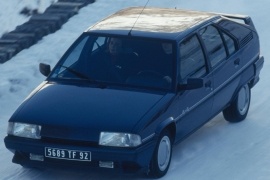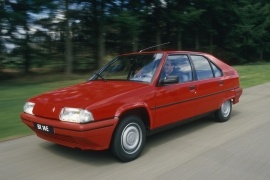CITROEN BX Models/Series Timeline, Specifications & Photos
First production year: 1983
Engines: Gasoline, Diesel
Body style: Hatchback
The Citroen BX was the car that saved the Citroen brand from collapse. After the 1986 refresh, in 1989 there was a new range of engines installed in the car, to cope with the market requirements.
The Citroen BX was built to replace the aged GSA model. Its design was created by Marcello Gandini from Bertone Studios. It was the same designer that shaped the Lamborghini Countach. The initial design was offered in 1979 to Volvo as a concept car named Tundra, but the Sweedish company thought it was too much for that era. Citroen bought the project and asked Bertone to make it a 4-door hatchback. And the “origami-design” was approved and appreciated by the Peugeot-Citroen board.
In 1989 the BX received a new design for wheel-caps and door handles. It featured the same straight-lines design, with angular greenhouse and sharp front-end. The transverse-engine architecture allowed the engines to be mounted tilted rearward so it could have a narrow front end.
Inside, the instrument cluster was cluttered with more dials, especially for the top versions that featured an electronic fuel-injection system. But it was still easy to read. The side-satellites for the turn-signals were replaced with regular stalks. Even though the car was considered as a medium-sized vehicle, it was cramped even by 1982 standards when the car was shown. In 1989 it was even more difficult.
There were few new engines installed for the 1989 model, but the most important improvement was the introduction of the all-wheel-drive system with the 1.9-liter gasoline engine.
Just three years after the model's introduction, Citroen decided to launch an updated version of its compact-sized BX in 1986, bringing better engines and an enhanced overall look for the car.
Thanks to the funds obtained from its parent company Peugeot, Citroen was back in business, and the BX sold well. But since the original model was designed in the late '70s, by the mid-80s, it already looked old. So the automaker improved the vehicle in several areas.
The most significant difference was at the front, where the car got clear-lens turn signals. By fitting them with amber-light bulbs, these could respect the requirements for safety while still offering a cool look. On the sides, most trim levels received a black rubber strip that crossed the car from front to back to protect the bodywork from paint chips in tight parking lots. The lower trim levels, on the other hand, sported unpainted, black bumpers, very effective for street parking in Paris.
Inside, the carmaker used the same angular design language but vastly improved over its predecessor. It sported round dials inside the instrument cluster and regular stalks for blinkers and a window wiper (yes, it was just one) instead of satellites mounted on the dash with buttons and turning knobs. Moreover, the steering wheel sported a thicker center area.
Under the hood, Citroen installed an unusually wide engine range for its segment. The most powerful version provided 160 PS (158 hp), and a new turbo-diesel with 90 ponies (89 hp) promised better fuel efficiency while still offering decent performance for those times.
CITROEN BX 1.4L 4MT FWD (63 HP)
CITROEN BX 1.4L 5MT FWD (72 HP)
CITROEN BX 1.6L 4AT FWD (75 HP)
CITROEN BX 1.6L 4AT FWD (94 HP)
CITROEN BX 1.6L 5MT FWD (105 HP)
CITROEN BX 1.6L 5MT FWD (75 HP)
CITROEN BX 1.6L 5MT FWD (94 HP)
CITROEN BX 1.9L 4AT FWD (103 HP)
CITROEN BX 1.9L 4AT FWD (105 HP)
CITROEN BX 1.9L 4AT FWD (125 HP)
CITROEN BX 1.9L 4AT FWD (97 HP)
CITROEN BX 1.9L 5MT FWD (103 HP)
CITROEN BX 1.9L 5MT FWD (105 HP)
CITROEN BX 1.9L 5MT FWD (125 HP)
Citroen started working on the BX model in the '70s, but its bankruptcy put the project on hold until Peugeot bought the carmaker and financed it.
The car was designed to replace the GS model, which was on the market since 1970. Still, there was a disagreement regarding the exterior design, which calmed down after the carmaker bought the Volvo Tundra project from Bertone Studios. Volvo rejected it because it was considered too bold but fitted Citroen's needs like a glove. Despite its angular shapes, the hatchback featured a lower drag coefficient than the GS's, and its size matched the carmaker's needs. Moreover, its platform was cheaper than the one used for the GS. It featured McPherson struts at the front instead of double-wishbones. Still, it worked well together with the already famous hydropneumatic, self-leveling suspension system.
On the outside, it looked like the designers used only rulers and straight-angles to design the car. Its squared headlights with small, corner-mounted turn signals flanked the front of the hood, which was angled down. Citroen cooled the engine through a grille-mounted in the lower side of the wrapped-around plastic bumper. On the sides, the flush door handles and the flat body panels were completely different than the rounded shapes used by Citroen before. The raked-forward C-pillars and tailgate formed a Kammback styling at the back, while the taillights were also squared.
Inside, the French carmaker installed a squared-looking dashboard with flat panels. The instrument cluster featured most of the buttons mounted on the sides, including the turn-signal rocker-switcher, which had to be turned off by the driver. A one-spoke steering wheel was unusual for other carmakers, but not for Citroen, who used that system since the '50s. Thanks to the transverse-mounted engine, the car offered enough room for up to five passengers.
Under the hood, Citroen relied on Peugeot's engines with 1.4-liter and 1.6-liter displacements. Later on, the carmaker added more powerplants to the BX lineup.


